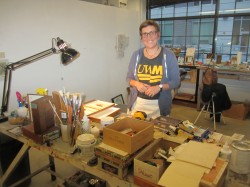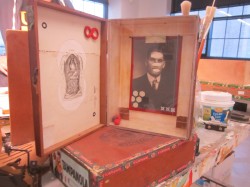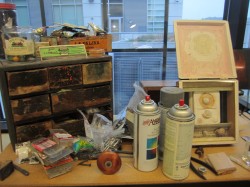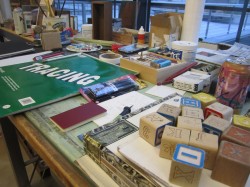Josie Osborne
Chance connections have driven the life of this art instructor and arts advocate.
If you ever get the chance to enter Josie Osborne’s century-old house in Riverwest, be sure to ask about the assemblage box on her mantel. She’ll tell you about Chance and Glue. It’s the name of the box, the poem that inspired it and, in a way, the mentality that’s driven her life.
Osborne’s own career is a collage of experiences revolving around art; she worked at the Milwaukee Institute of Art and Design for nine years, was involved in the K-12 Arts Initiative Program in Milwaukee Public Schools and served on the Board of Latino Arts. Currently, she works as Director of the First Year Program in Art and Design at UW-Milwaukee, and also serves on the Milwaukee Arts Board.
Reacting to the trend of harsh cuts in arts and music programs in public schools, Osborne is amongst the teachers, parents and students advocating for art in the Milwaukee Public Schools.
Osborne began building assemblage boxes while pursuing her M.F.A in Graphics at UW-Madison; she was captivated by the poetry that arises in bringing two seemingly unrelated things together in her boxes. “Something happens in that juxtaposition,” she says, “it has this power to allude to things that words can’t say.” Sitting on a stool in her studio in the Peck School of the Arts building on Kenilworth Avenue, her gaze falls to her art supplies as she recalls making that first assemblage box.
Osborne made the piece in response to a poem written about her grad school professor, Walter Hamady, by his friend, William Stafford, about a playful, wild day the two old men had shared. Stafford passed away shortly after writing it. Hamady read the poem, “Chance and Glue,” to the class and asked them, simply, to make something. Osborne was moved by the two old men’s fling with life, the mosaic of experiences that happened in a single day, and went home to create the first assemblage box “that worked,” as she recalls it.
She went on to create many more assemblage boxes; her studio reflects the value she places on unexpected connections, making memorable art out of odds and ends. Pulling back the heavy sliding door, she reveals a studio where tables are askew with lettered building blocks, jars of paint brushes and half a dozen assemblage boxes. A drawer made from old cigar boxes holds nuts and bolts and chicken bones.
Osborne splits her time between this studio and the UW-Milwaukee campus where she works with beginning arts students. She gets to be, for some of them, the first piece of their own collage of experiences. Osborne says that art often leads her to things she needed to learn about herself, and she sees that happening with the students.
“I’ve had students that were so surprised by how passionate, how involved they got,” she says. “You know, students that were saying ‘I just took this because I thought it would be an easy elective.’ People don’t realize how much work art is.”
Osborne recently reached her 10-year milestone as a volunteer serving on the Milwaukee Arts Board. “Every city needs an art board to advocate for the arts,” she says. “We can remind the Common Council and the mayor that it’s important and keep the dialogue about the importance of arts and culture alive.”
The Milwaukee Arts Board has a grants program that gives money to nonprofits every year to help them finish art-related projects. Osborne says the projects can be catalysts for discussion about the city; lately, she says, she’s been very interested in temporary public art in Milwaukee. She notes the work of Pegi Christiansen and the non-profit she heads called IN:SITE, which gives people who aren’t as prominent in the Milwaukee arts community the opportunity to put their often site-specific artwork in the public realm.
Public art, she says, evokes conversation about the community, good or bad. “It makes you think about place, makes you think about what does that (art) mean there?”
Osborne has also spent time creating arts programs for younger students. Prior to UW-Milwaukee, she served as Director of Community Outreach at the Milwaukee Institute of Art & Design, where she implemented nationally recognized programming that gave middle and high school aged kids experience with art and design.
“I think everyone has this innate need to express themselves and it can happen in many different ways.” says Osborne. And art needn’t be limited to visual creations, but can involve music, creative writing, poetry, or movement. “You see kids who naturally do that, they just hunger for it and it needs to be kept alive because so much of the way our culture trains people tends to shut that down.”
Osborne’s advocacy for the freedom of expression extends into the political sphere. This autumn, she hit the pavement with her wife, Kim, and friends, knocking on doors canvassing for the 2012 election and driving voters to polling places on election day. We don’t think about how difficult it is for some people to get to the polls, Osborne says. The work is rewarding because every person they transport is someone that might not have gotten there otherwise.
Back on that mantel, overlooking the constellation of rugs pieced together to allow Osborne’s rescued dog, who has a fear of shiny floors, to get around the house, sits Osborne’s first encounter with Chance and Glue. From her kitchen, a kind of assemblage piece of cabinets salvaged by her and her wife, to her studio, her classroom and her work in her community, you can see the way her life has glued together all those disparate pieces of experience.
City People
-
New Public Allies Leader Comes Full Circle
 Nov 2nd, 2021 by Sam Woods
Nov 2nd, 2021 by Sam Woods
-
Dr. Lester Carter, a Community Anchor for 47 Years
 Jul 2nd, 2021 by Damia S. Causey
Jul 2nd, 2021 by Damia S. Causey
-
Reuben Harpole Found His Purpose
 May 13th, 2021 by PrincessSafiya Byers
May 13th, 2021 by PrincessSafiya Byers
























